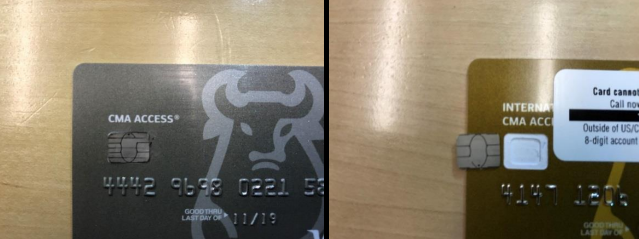Debit cards can help you better manage your finances but there's an alarming new risk: Criminals are targeting computer chips in new debit cards, replacing them with stolen ones to commit massive fraud, according to the U.S. Secret Service.
Here's how the scam works, according to KrebsonSecurity: Thieves are focusing efforts on brand new cards, targeting banks and other financial institutions such as credit unions which issue and mail them directly to big companies. Financial institutions were notified of this scam late in March, according to Krebs.
Criminals are intercepting large packages of debit cards when financial institutions send out new cards to businesses. They melt the glue on the back and remove the card's EMV chip, swapping it with a new fraudulent one.
Once the cards are activated by unsuspecting users in the company (via phone or website), the criminals are able to wipe out the companies' checking accounts via the stolen chips. The actual card won't work because it has an old, bad chip.
The Secret Service memo doesn't state how the criminals are gaining access to the mail—whether they are obtaining the cards through the U.S. Postal Service or other mail delivery companies, or are accessing the mail of the companies issuing the cards.
What You Should Look Out For
This scam is targeting businesses currently, but it's a good idea for consumers to know about it (since we never know when scammers might adjust their target). Be suspicious if the envelope or package your debit card arrives in looks like its been tampered with. Also, check the chip on your card to make sure it's not sticking up above the card. If anything seems off, contact your bank, tell them of your concerns, and request a new card before activating it.

Source: Secret Service
What To Do If Your Debit Card Is Compromised or Stolen
Here are three important steps you should take if you're a victim of this or another card scam:
1. Cancel Your Card
Call your bank or card issuer and request a new credit or debit card. If a debit card was involved, you'll also want to change the PIN on the account. Some banks and issuers automatically shut down your card and send a new one when they know it's been compromised.
2. Check Your Account
While you're on the phone canceling your card, you should also notify your bank or financial institution that you have been the victim of fraud. You'll also want to go online to check recent activity. Unfortunately, with this scam you may not find out about the theft until a purchase is flagged or clears unless you spot something phishy yourself online.
If your card has already been used, you'll need to make sure you dispute the charges with your bank immediately. This process can be a bit lengthier when dealing with debit card fraud, but you'll want to flag any potential debit or credit card fraud as soon as possible.
With a debit card, you have 60 days to report an unauthorized transaction from the time you receive your statement because the card number was stolen and the card wasn't lost. (Note: According to the FTC, if your debit card is stolen and used, you could end up being responsible for up to $500.)
3. Monitor Your Accounts
With a debit card, you likely don't have to worry about other types of identity theft. However, it's always a good idea to continue reviewing all bank and credit card statements each month and regularly checking your credit report for any identity theft red flags. Additionally, many banks let you set up alerts via email or text to notify you of large purchases.
Learn more here on Experian.com about other new scams and what to do if your credit card or debit card is involved in a data breach.

